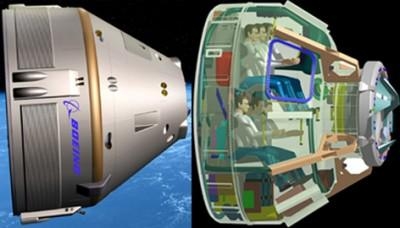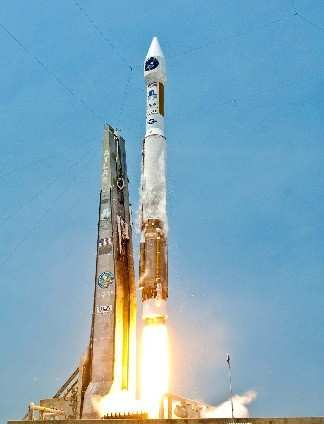Sat, Sep 15, 2012
Integrated Systems Review Proposes CST-100 Spacecraft Boosted By An Atlas V Launch Vehicle
The Boeing Company has completed its first performance milestone for NASA's Commercial Crew Integrated Capability (CCiCap) initiative, which is intended to lead to the availability of human spaceflight transportation services for government and commercial customers. In its Integrated Systems Review (ISR), Boeing presented the latest designs of its CST-100 spacecraft, United Launch Alliance's Atlas V rocket launch system, and ground and mission operations. These designs will serve as the baseline for further development work to be accomplished during CCiCap. The company also discussed its plans for safety and mission assurance, which ultimately will contribute to achieving certification of the system for human spaceflight.

"The ISR established a firm baseline configuration that will allow our team to push forward with the final vehicle design", said John Mulholland, Boeing vice president and program manager for Commercial Programs. "We hope the rigor of our design and development process, and our outstanding team of suppliers will help position the CST-100 as one of the next crew transportation vehicles to the space station and other low Earth orbit destinations."
Technical experts from NASA's Commercial Crew Program (CCP) participated in the review in Houston. They are in the process of providing comments and advice based on more than 50 years of human spaceflight experience.

"All of our industry partners are gearing up to push their human spaceflight technologies further than ever before so America can have its own crew transportation system around the middle of the decade," said Ed Mango, CCP's program manager. "This review was just the first of many exciting and valuable milestones Boeing is expected to complete during its funded partnership with NASA."
At the review, Boeing also presented results from numerous tests that were conducted as part of its earlier Commercial Crew Development Round Two Space Act Agreement with NASA. These tests included parachute and air bag drops, abort engine firings and wind tunnel tests. NASA's new CCiCap agreements follow two previous commercial endeavors by the agency to spur the development of crew transportation systems and subsystems. Work by NASA's industry partners during CCiCap will set the stage for a crewed orbital demonstration mission around the middle of the decade.
Future development and certification initiatives eventually will lead to the availability of human spaceflight services for NASA to send its astronauts to the International Space Station. The overall goal of NASA's commercial space efforts is to make low Earth orbit more accessible and open for business for other government and commercial customers.
(Images Top Boeing CST-100, Bottom ULA Atlas V launch)
More News
Circle To Runway (Runway Number) Used by ATC to inform the pilot that he/she must circle to land because the runway in use is other than the runway aligned with the instrument appr>[...]
Aero Linx: National Aviation Safety Foundation (NASF) The National Aviation Safety Foundation is a support group whose objective is to enhance aviation safety through educational p>[...]
At Altitude Of About 250-300 Ft Agl, The Airplane Experienced A Total Loss Of Engine Power On November 6, 2024, at 1600 central standard time, a De Havilland DHC-1, N420TD, was inv>[...]
From 2009 (YouTube Edition): Three Hour Flight Was 'Flawless' -- At Least, Until Mother Nature Intervened For anyone who loves the aviation business, this was a VERY good day. Afte>[...]
Also: AMA Names Tyler Dobbs, More Falcon 9 Ops, Firefly Launch Unsuccessful, Autonomous F-16s The Air Force has begun ground testing a future uncrewed jet design in a milestone tow>[...]
 ANN's Daily Aero-Term (05.05.25): Circle To Runway (Runway Number)
ANN's Daily Aero-Term (05.05.25): Circle To Runway (Runway Number) ANN's Daily Aero-Linx (05.05.25)
ANN's Daily Aero-Linx (05.05.25) NTSB Prelim: De Havilland DHC-1
NTSB Prelim: De Havilland DHC-1 Classic Aero-TV: The Boeing Dreamliner -- Historic First Flight Coverage
Classic Aero-TV: The Boeing Dreamliner -- Historic First Flight Coverage Airborne-NextGen 05.06.25: AF Uncrewed Fighters, Drones v Planes, Joby Crew Test
Airborne-NextGen 05.06.25: AF Uncrewed Fighters, Drones v Planes, Joby Crew Test




